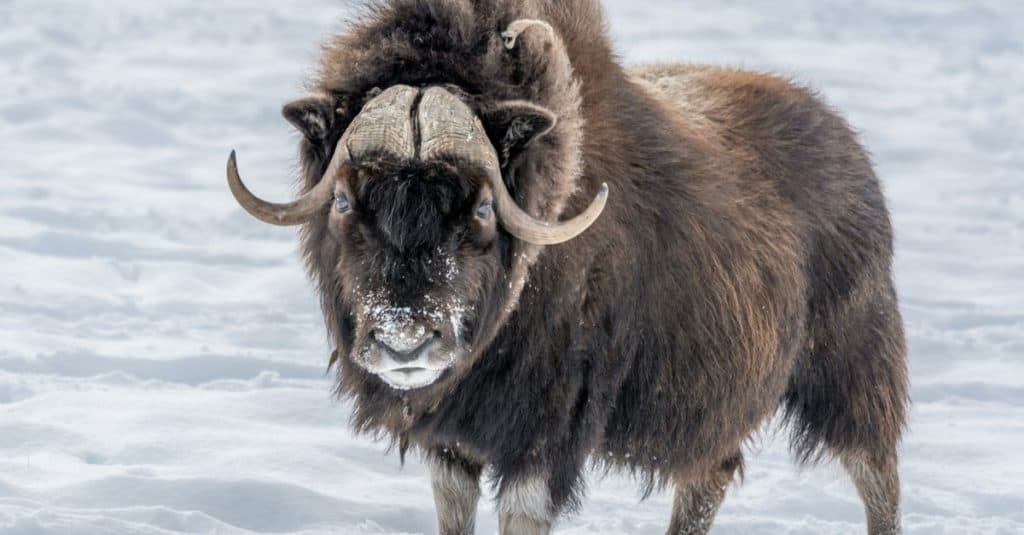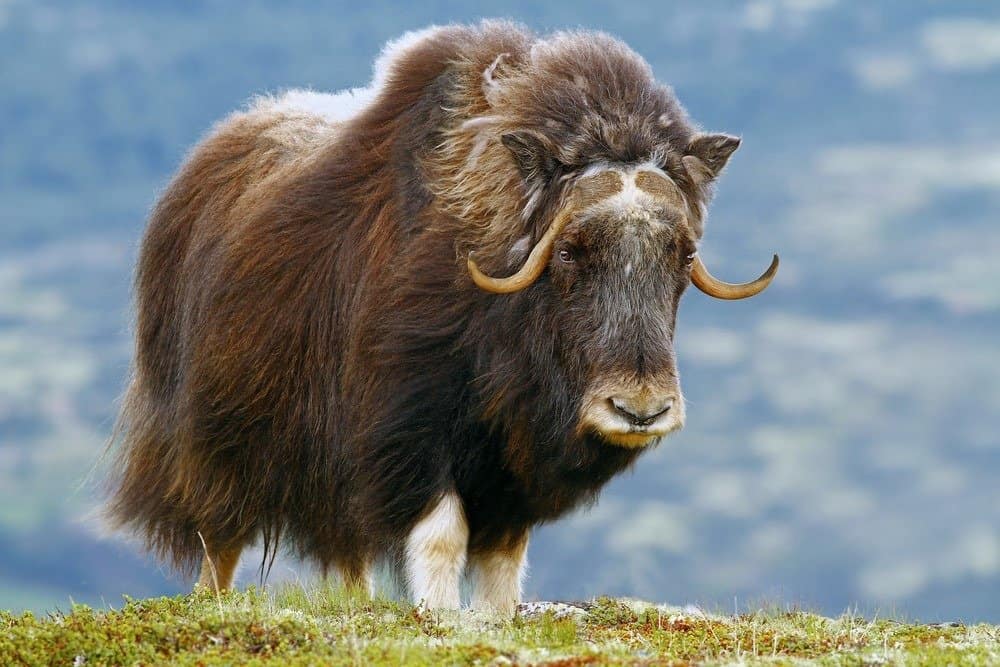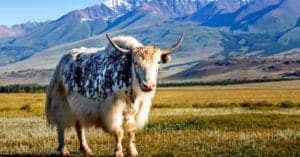English speakers know it as the musk ox, but throughout history, it has been called the “ugly moose,” the “bearded one,” and the “ugly bison.”
Muskoxen are massive hooved animals native to the arctic circle. They boast an inner layer of wooly underfur and an outer layer of draping hair. In fact, their hair is the longest of all North American mammals. This warm coat allows them to survive the driven ice, snow, and blisteringly cold temperatures of the Arctic.
They’re stout and brawny, like furry 800-pound barrels with short legs and horns. Their horns are only a few feet long, draping down the sides of their head and bowing back upward.
Let’s learn a little more about these unique and majestic Arctic giants, along with the largest one ever caught in Alaska.
What is a Musk Ox?

The musk ox is more closely related to
antelope
, sheep, and goats than to cattle.
©Fitawoman/Shutterstock.com
The appearance of a musk ox gives the impression that it’s closely related to cattle. Additionally, the name “musk ox” is misleading. Ox” is a term encompassing modern cattle domesticated from the aurochs around 4,000 years ago. That means oxen are actually a human-influenced species that didn’t evolve naturally. The musk ox, on the other hand, evolved naturally. It is more closely related to antelope, sheep, and goats than to cattle.
The family Bovidae encompasses most cloven-hoofed, even-toed ungulates. Bovidae splits into Boodontia (bovines such as cattle and bison) and Aegodontia (animals such as impalas, muskoxen, and sheep). From there, a number of subfamilies branch out including the subfamily Caprinae.
Caprinae includes many amazing hooved animals, including the Armenian mouflon, which is most likely the common ancestor of domesticated sheep. Here, we also find domesticated goats, mountain goats, ibex, and turs.
The two largest members of this subfamily look very different from their fellow subfamily members, which is why we misidentify them. These are muskoxen and takins.
Muskoxen and takins underwent a period of convergent evolution. This made them look quite similar to each other, even though there are a few degrees of separation between them. Takins live at high altitudes, predominantly around the Himalayas. The Greek legend of the golden fleece is thought to have originated with one golden takin.
Habitat, Diet, & Distribution
Muskoxen are herbivores that eat mostly roots, mosses, and grasses. To search for plants, they sift through the deep snow, which can be pretty difficult in their habitat.
These animals live in the Arctic circle. Healthy populations exist in Greenland, Canada, Siberia, Scandinavia, and Alaska. Their extensive fur helps them stay warm when temperatures reach -40 degrees Fahrenheit. Their underfur falls out when temperatures rise in the summer. Most of their time is spent in herds of around 30 individuals.
Tightly packed herds help muskoxen stay warm, but also aid them in defending against their myriad predators. These giants are formidable, but they’re still vulnerable to Arctic wolves, polar bears, and the occasional Kodiak or grizzly bear.
When a herd is threatened, it typically gains higher ground, before making a shoulder-to-shoulder wall or ring, with the youngest and most vulnerable individuals in the center. A few brave soldiers might charge out to attack, but muskoxen take the defensive approach for the most part.
Humans are also a threat, as muskoxen hunting once brought the species incredibly close to extinction. Reintroduction efforts over the last century have brought these animals back to a conservation classification of “least concern.”
The Largest Musk Ox Ever Caught in Alaska

Muskoxen are rated based on the size and proportion of their horns, a measurement which translates very closely to the animal’s overall size.
©Martin Hejzlar/Shutterstock.com
Muskoxen hunting requires tags, documentation, and very experienced guides. These animals are rated based on the size and proportion of their horns, a measurement which translates very closely to the animal’s overall size.
As far as Alaska’s big game records go, there are two muskoxen tied for the size record. Both share a size score of 129 & 0/8. If you’re curious, you can see how these scores are measured here.
One of these title-holding hunters caught the prize-winning bull on his first hunt ever.
The Prize-Winning Hunt
In 2002, Craig D. Scott went out on an expedition after being selected from a permit lottery. There’s an application process to hunt muskoxen, but no guarantee that you’ll be chosen if you apply.
Scott had never seen a musk ox in nature before, so he consulted with an Alaskan biologist named Richard Popko to get some pointers. As he sat in Popko’s office asking what to look for, the biologist pointed to a large photo above his desk.
Referencing the massive musk ox in the photo, he said “this is what you want to look for.” Later, Scott went out on his first expedition in the deep snow. His group spotted a small herd after walking for a couple of miles. The leader of the expedition pointed out a massive bull fronting the herd, which was to become the record-holding bull.
Before the horns were officially scored, Craig Scott brought a photo of the animal back to Richard Popko. He had actually shot the exact animal in the photo above Popko’s desk.
Where is Alaska Located on the Map?
Alaska may be considered a huge chunk carved out of western Canada. It sits across Russia separated by the Bering Strait. Its city of Wales, named after the nation of Wales, is the United States’s westernmost point.
Up Next:
- Muskox
- The 10 Largest Animals in North America
- 10 Animals That Yield Wool
- Beyond Reindeer: 7 Animals That Live in Earth’s Coldest Places
The photo featured at the top of this post is © NaturesMomentsuk/Shutterstock.com
Thank you for reading! Have some feedback for us? Contact the AZ Animals editorial team.






